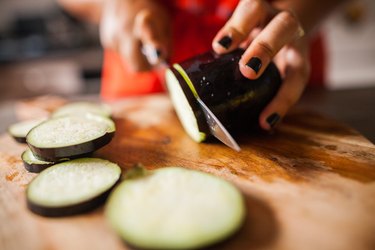
Small eggplants are tender enough to cook without much prep, but larger eggplants need a bit more attention.
You can improve the taste and texture of large, mature eggplants by "sweating" them to draw out bitter-tasting juices. This also helps collapse cell membranes, reducing the sponge-like capacity of the vegetable's flesh to soak up oil.
Video of the Day
Video of the Day
Can You Eat Eggplant Seeds?
Yes, eggplant seeds are edible but they can be bitter. The seeds of a fresh eggplant should be soft and barely visible and if they are, there's no need to remove them. If seeds are brown, scoop them out with a spoon to reduce the bitterness in your recipe.
How to Choose Eggplant
When you're at the grocery store, make sure to heed these tips for picking the perfect eggplant:
- The skin should be smooth, shiny and wrinkle-free.
- When you press into the flesh, it should spring back immediately.
- Ideally, the stem should look a little moist, as though freshly cut.
Use the eggplant as soon as possible after buying, but it will stay fresh in the crisper for two to three days. Remove any brown or hardened spots in the flesh. If you see too much discoloration and the seeds are also brown, the eggplant is past its prime and you should get another one.
How to Prepare Eggplant
Things You'll Need
2 large eggplants
Paring knife
Kosher or coarse sea salt
Colander
Paper towels
1. Wash the Eggplant
Clean the eggplant by washing it under cold running water. There's no need to use soap — plain tap water is enough, per the U.S. Food and Drug Administration.
2. Peel the Eggplant in Stripes
Slice off the top and peel the eggplant in stripes, leaving some of the skin on.
The purplish-black skin on large eggplants tends to be tough but it's also rich in antioxidants, per a March 2021 report in Plants. Peeling the vegetable in "stripes" keeps some of those nutrients.
You don't have to peel the eggplant: If you're planning to grill it, keeping the skin will help the slices retain their shape.
3. Cut the Eggplant Into Pieces (Optional)
Cut the eggplant into pieces. Your recipe will dictate the preferred size and shape.
4. Salt the Eggplant
Sprinkle salt generously over all surfaces of the pieces.
Unless the recipe you're using specifically takes "sweating" the eggplant into account, cut the amount of salt it calls for by half.
5. Drain in a Colander
Set the eggplant pieces in a colander to drain. Almost immediately, you'll see little beads of "sweat" starting to form on the eggplant. Leave the colander for about an hour.
6. Pat the Eggplant Dry
Pat the pieces dry with paper towels. After this, your eggplant is ready to be cooked.
Related Reading